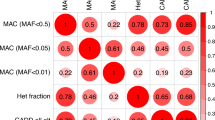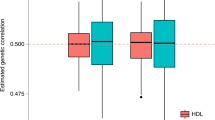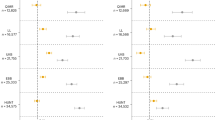Abstract
Identifying genetic correlations between complex traits and diseases can provide useful etiological insights and help prioritize likely causal relationships. The major challenges preventing estimation of genetic correlation from genome-wide association study (GWAS) data with current methods are the lack of availability of individual-level genotype data and widespread sample overlap among meta-analyses. We circumvent these difficulties by introducing a technique—cross-trait LD Score regression—for estimating genetic correlation that requires only GWAS summary statistics and is not biased by sample overlap. We use this method to estimate 276 genetic correlations among 24 traits. The results include genetic correlations between anorexia nervosa and schizophrenia, anorexia and obesity, and educational attainment and several diseases. These results highlight the power of genome-wide analyses, as there currently are no significantly associated SNPs for anorexia nervosa and only three for educational attainment.
This is a preview of subscription content, access via your institution
Access options
Subscribe to this journal
Receive 12 print issues and online access
$209.00 per year
only $17.42 per issue
Buy this article
- Purchase on SpringerLink
- Instant access to full article PDF
Prices may be subject to local taxes which are calculated during checkout


Similar content being viewed by others
References
Smith, G.D. & Ebrahim, S. Mendelian randomization: can genetic epidemiology contribute to understanding environmental determinants of disease? Int. J. Epidemiol. 32, 1–22 (2003).
Smith, G.D. & Hemani, G. Mendelian randomization: genetic anchors for causal inference in epidemiological studies. Hum. Mol. Genet. 23 (R1), R89–R98 (2014).
Vandenberg, S.G. in Methods and Goals in Human Behavior Genetics 29–43 (cademic Press, 1965).
Kempthorne, O. & Osborne, R.H. The interpretation of twin data. Am. J. Hum. Genet. 13, 320–339 (1961).
Loehlin, J.C. & Vandenberg, S.G. in Progress in Human Behavior Genetics (ed. Vandenberg, S.G.) 261–285 (Johns Hopkins Univ. Press, 1968).
Neale, M. & Cardon, L. Methodology for Genetic Studies of Twins and Families Number 67 (Springer, 1992).
Lichtenstein, P. et al. Common genetic determinants of schizophrenia and bipolar disorder in Swedish families: a population-based study. Lancet 373, 234–239 (2009).
Voight, B.F. et al. Plasma HDL cholesterol and risk of myocardial infarction: a Mendelian randomisation study. Lancet 380, 572–580 (2012).
Do, R. et al. Common variants associated with plasma triglycerides and risk for coronary artery disease. Nat. Genet. 45, 1345–1352 (2013).
Visscher, P.M., Brown, M.A., McCarthy, M.I. & Yang, J. Five years of GWAS discovery. Am. J. Hum. Genet. 90, 7–24 (2012).
Yang, J. et al. Common SNPs explain a large proportion of the heritability for human height. Nat. Genet. 42, 565–569 (2010).
Yang, J., Lee, S.H., Goddard, M.E. & Visscher, P.M. GCTA: a tool for genome-wide complex trait analysis. Am. J. Hum. Genet. 88, 76–82 (2011).
Lee, S.H., Yang, J., Goddard, M.E., Visscher, P.M. & Wray, N.R. Estimation of pleiotropy between complex diseases using single-nucleotide polymorphism–derived genomic relationships and restricted maximum likelihood. Bioinformatics 28, 2540–2542 (2012).
Cross-Disorder Group of the Psychiatric Genomics Consortium. Genetic relationship between five psychiatric disorders estimated from genome-wide SNPs. Nat. Genet. 45, 984–994 (2013).
Vattikuti, S., Guo, J. & Chow, C.C. Heritability and genetic correlations explained by common SNPs for metabolic syndrome traits. PLoS Genet. 8, e1002637 (2012).
Chen, G.-B. et al. Estimation and partitioning of (co) heritability of inflammatory bowel disease from GWAS and Immunochip data. Hum. Mol. Genet. 23, 4710–4720 (2014).
Purcell, S.M. et al. Common polygenic variation contributes to risk of schizophrenia and bipolar disorder. Nature 460, 748–752 (2009).
Dudbridge, F. Power and predictive accuracy of polygenic risk scores. PLoS Genet. 9, e1003348 (2013).
Bulik-Sullivan, B.K. et al. LD score regression distinguishes confounding from polygenicity in genome-wide association studies. Nat. Genet. 47, 291–295 (2015).
Yang, J. et al. Genomic inflation factors under polygenic inheritance. Eur. J. Hum. Genet. 19, 807–812 (2011).
Speed, D., Hemani, G., Johnson, M.R. & Balding, D.J. Improved heritability estimation from genome-wide SNPs. Am. J. Hum. Genet. 91, 1011–1021 (2012).
Cross-Disorder Group of the Psychiatric Genomics Consortium. et al. Identification of risk loci with shared effects on five major psychiatric disorders: a genome-wide analysis. Lancet 381, 1371–1379 (2013).
Perry, J.R. et al. Parent-of-origin-specific allelic associations among 106 genomic loci for age at menarche. Nature 514, 92–97 (2014).
Morris, A.P. et al. Large-scale association analysis provides insights into the genetic architecture and pathophysiology of type 2 diabetes. Nat. Genet. 44, 981–990 (2012).
Horikoshi, M. et al. New loci associated with birth weight identify genetic links between intrauterine growth and adult height and metabolism. Nat. Genet. 45, 76–82 (2013).
Freathy, R.M. et al. Type 2 diabetes risk alleles are associated with reduced size at birth. Diabetes 58, 1428–1433 (2009).
Early Growth Genetics (EGG) Consortium. A genome-wide association meta-analysis identifies new childhood obesity loci. Nat. Genet. 44, 526–531 (2012).
Taal, H.R. et al. Common variants at 12q15 and 12q24 are associated with infant head circumference. Nat. Genet. 44, 532–538 (2012).
Onland-Moret, N.C. et al. Age at menarche in relation to adult height: the EPIC study. Am. J. Epidemiol. 162, 623–632 (2005).
Day, F. et al. Puberty timing associated with diabetes, cardiovascular disease and also diverse health outcomes in men and women: the UK Biobank study. Sci. Rep. 5, 11208 (2014).
Elks, C.E. et al. Age at menarche and type 2 diabetes risk: the EPIC-InterAct study. Diabetes Care 36, 3526–3534 (2013).
Finucane, H.K. et al. Partitioning heritability by functional category using genome-wide association study summary statistics. Nat. Genet. doi:10.1038/ng.3404 (28 September 2015).
Farooqi, I.S. Defining the neural basis of appetite and obesity: from genes to behaviour. Clin. Med. 14, 286–289 (2014).
Wang, N. et al. Associations of adult height and its components with mortality: a report from cohort studies of 135,000 Chinese women and men. Int. J. Epidemiol. 40, 1715–1726 (2011).
Hebert, P.R. et al. Height and incidence of cardiovascular disease in male physicians. Circulation 88, 1437–1443 (1993).
Rich-Edwards, J.W. et al. Height and the risk of cardiovascular disease in women. Am. J. Epidemiol. 142, 909–917 (1995).
Rietveld, C.A. et al. GWAS of 126,559 individuals identifies genetic variants associated with educational attainment. Science 340, 1467–1471 (2013).
Barnes, D.E. & Yaffe, K. The projected effect of risk factor reduction on Alzheimer's disease prevalence. Lancet Neurol. 10, 819–828 (2011).
Norton, S., Matthews, F.E., Barnes, D.E., Yaffe, K. & Brayne, C. Potential for primary prevention of Alzheimer's disease: an analysis of population-based data. Lancet Neurol. 13, 788–794 (2014).
MacCabe, J.H. et al. Excellent school performance at age 16 and risk of adult bipolar disorder: national cohort study. Br. J. Psychiatry 196, 109–115 (2010).
Tiihonen, J. et al. Premorbid intellectual functioning in bipolar disorder and schizophrenia: results from a cohort study of male conscripts. Am. J. Psychiatry 162, 1904–1910 (2005).
Pierce, J.P., Fiore, M.C., Novotny, T.E., Hatziandreu, E.J. & Davis, R.M. Trends in cigarette smoking in the United States: educational differences are increasing. J. Am. Med. Assoc. 261, 56–60 (1989).
Striegel-Moore, R.H., Garvin, V., Dohm, F.-A. & Rosenheck, R.A. Psychiatric comorbidity of eating disorders in men: a national study of hospitalized veterans. Int. J. Eat. Disord. 25, 399–404 (1999).
Blinder, B.J., Cumella, E.J. & Sanathara, V.A. Psychiatric comorbidities of female inpatients with eating disorders. Psychosom. Med. 68, 454–462 (2006).
Deary, I.J., Strand, S., Smith, P. & Fernandes, C. Intelligence and educational achievement. Intelligence 35, 13–21 (2007).
Calvin, C.M., Fernandes, C., Smith, P., Visscher, P.M. & Deary, I.J. Sex, intelligence and educational achievement in a national cohort of over 175,000 11-year-old schoolchildren in England. Intelligence 38, 424–432 (2010).
Durkin, M.S. et al. Socioeconomic inequality in the prevalence of autism spectrum disorder: evidence from a US cross-sectional study. PLoS ONE 5, e11551 (2010).
Robinson, E.B. et al. Autism spectrum disorder severity reflects the average contribution of de novo and familial influences. Proc. Natl. Acad. Sci. USA 111, 15161–15165 (2014).
Samocha, K.E. et al. A framework for the interpretation of de novo mutation in human disease. Nat. Genet. 46, 944–950 (2014).
Silman, A.J. & Pearson, J.E. Epidemiology and genetics of rheumatoid arthritis. Arthritis Res. 4 (suppl 3), S265–S272 (2002).
de Leon, J. & Diaz, F.J. A meta-analysis of worldwide studies demonstrates an association between schizophrenia and tobacco smoking behaviors. Schizophr. Res. 76, 135–157 (2005).
Andreassen, O.A. et al. Improved detection of common variants associated with schizophrenia by leveraging pleiotropy with cardiovascular-disease risk factors. Am. J. Hum. Genet. 92, 197–209 (2013).
Cotsapas, C. et al. Pervasive sharing of genetic effects in autoimmune disease. PLoS Genet. 7, e1002254 (2011).
Farh, K.K. et al. Genetic and epigenetic fine mapping of causal autoimmune disease variants. Nature 518, 337–343 (2015).
Wurtz, P. et al. Metabolic signatures of adiposity in young adults: Mendelian randomization analysis and effects of weight change. PLoS Med. 11, e1001765 (2014).
Burgess, S., Freitag, D.F., Khan, H., Gorman, D.N. & Thompson, S.G. Using multivariable Mendelian randomization to disentangle the causal effects of lipid fractions. PLoS ONE 9, e108891 (2014).
Greenland, S., Pearl, J. & Robins, J.M. Causal diagrams for epidemiologic research. Epidemiology 10, 37–48 (1999).
Dahl, A., Hore, V., Iotchkova, V. & Marchini, J. Network inference in matrix-variate Gaussian models with non-independent noise. arXivhttp://arxiv.org/abs/1312.1622 (2013).
Angrist, J.D. & Pischke, J-S. Mostly Harmless Econometrics: An Empiricist's Companion (Princeton Univ. Press, 2008).
Aschard, H., Vilhjálmsson, B.J., Joshi, A.D., Price, A.L. & Kraft, P. Adjusting for heritable covariates can bias effect estimates in genome-wide association studies. Am. J. Hum. Genet. 96, 329–339 (2015).
International HapMap 3 Consortium. Integrating common and rare genetic variation in diverse human populations. Nature 467, 52–58 (2010).
Acknowledgements
We would like to thank P. Sullivan, C. Bulik, S. Caldwell, C. Arabica and O. Andreassen for helpful comments. This work was supported by US National Institutes of Health (NIH) grants R01 MH101244 (A.L.P.), R01 HG006399 (N.P.), 1R01 MH101244-02 (B.M.N.), 5U01 MH094432-03 (B.M.N.) and R03 CA173785 (H.K.F.) and by the Fannie and John Hertz Foundation (H.K.F.). Data on anorexia nervosa were obtained by funding from the Wellcome Trust Case Control Consortium 3 project titled “A Genome-Wide Association Study of Anorexia Nervosa” (WT088827/Z/09). Data on glycemic traits were contributed by MAGIC investigators and were downloaded from http://www.magicinvestigators.org/. Data on coronary artery disease and myocardial infarction were contributed by CARDIoGRAMplusC4D investigators and were downloaded from http://www.cardiogramplusc4d.org/.
We thank the International Genomics of Alzheimer's Project (IGAP) for providing summary results data for these analyses. The investigators within IGAP contributed to the design and implementation of IGAP and/or provided data but did not participate in the analysis or writing of this report. IGAP was made possible by the generous participation of the control subjects, the patients and their families. The work with iSelect chips was funded by the French National Foundation on Alzheimer's Disease and Related Disorders. EADI was supported by a LABEX (Laboratory of Excellence Program Investment for the Future) DISTALZ grant, INSERM, Institut Pasteur de Lille, Université de Lille 2 and the Lille University Hospital. GERAD was supported by the Medical Research Council, UK (grant 503480), Alzheimer's Research UK (grant 503176), the Wellcome Trust (grant 082604/2/07/Z) and the German Federal Ministry of Education and Research (BMBF): Competence Network Dementia (CND) grants 01GI0102 and 01GI0711, 01GI0420. CHARGE was partly supported by US NIH/National Institute on Aging grants R01 AG033193 and AG081220 and AGES contract N01-AG-12100, National Heart, Lung, and Blood Institute (NHLBI) grant R01 HL105756, the Icelandic Heart Association, and the Erasmus Medical Center and Erasmus University. ADGC was supported by US NIH/National Institute on Aging grants U01 AG032984, U24 AG021886 and U01 AG016976 and Alzheimer's Association grant ADGC-10-196728.
Author information
Authors and Affiliations
Consortia
Contributions
M.J.D., A.G., P.-R.L., L.D., N.P., B.M.N. and A.L.P. provided reagents. E.B.R., V.A., J.R.B.P. and F.R.D. aided in the interpretation of results. J.R.B.P. and F.R.D. provided data on age at menarche. B.B.-S. and H.K.F. are responsible for the remainder. All authors revised and approved the final manuscript.
Corresponding authors
Ethics declarations
Competing interests
The authors declare no competing financial interests.
Additional information
A full list of members and affiliations appears in the Supplementary Note.
A full list of members and affiliations appears in the Supplementary Note.
A full list of members and affiliations appears in the Supplementary Note.
Supplementary information
Supplementary Text and Figures
Supplementary Figures 1–6, Supplementary Tables 1–3 and Supplementary Note. (PDF 1308 kb)
Supplementary Table 4
Table of genetic correlations. (CSV 63 kb)
Source data
Rights and permissions
About this article
Cite this article
Bulik-Sullivan, B., Finucane, H., Anttila, V. et al. An atlas of genetic correlations across human diseases and traits. Nat Genet 47, 1236–1241 (2015). https://doi.org/10.1038/ng.3406
Received:
Accepted:
Published:
Issue Date:
DOI: https://doi.org/10.1038/ng.3406
This article is cited by
-
Shared genetic effect of kidney function on bipolar and major depressive disorders: a large-scale genome-wide cross-trait analysis
Human Genomics (2024)
-
Genetic association and causal relationship between multiple modifiable risk factors and autoimmune liver disease: a two-sample mendelian randomization study
Journal of Translational Medicine (2024)
-
Genetic correlation between smoking behavior and gastroesophageal reflux disease: insights from integrative multi-omics data
BMC Genomics (2024)
-
Mendelian randomization analyses of known and suspected risk factors and biomarkers for myasthenia gravis overall and by subtypes
BMC Neurology (2024)
-
Unexpected identification of obesity-associated mutations in LEP and MC4R genes in patients with anorexia nervosa
Scientific Reports (2024)




